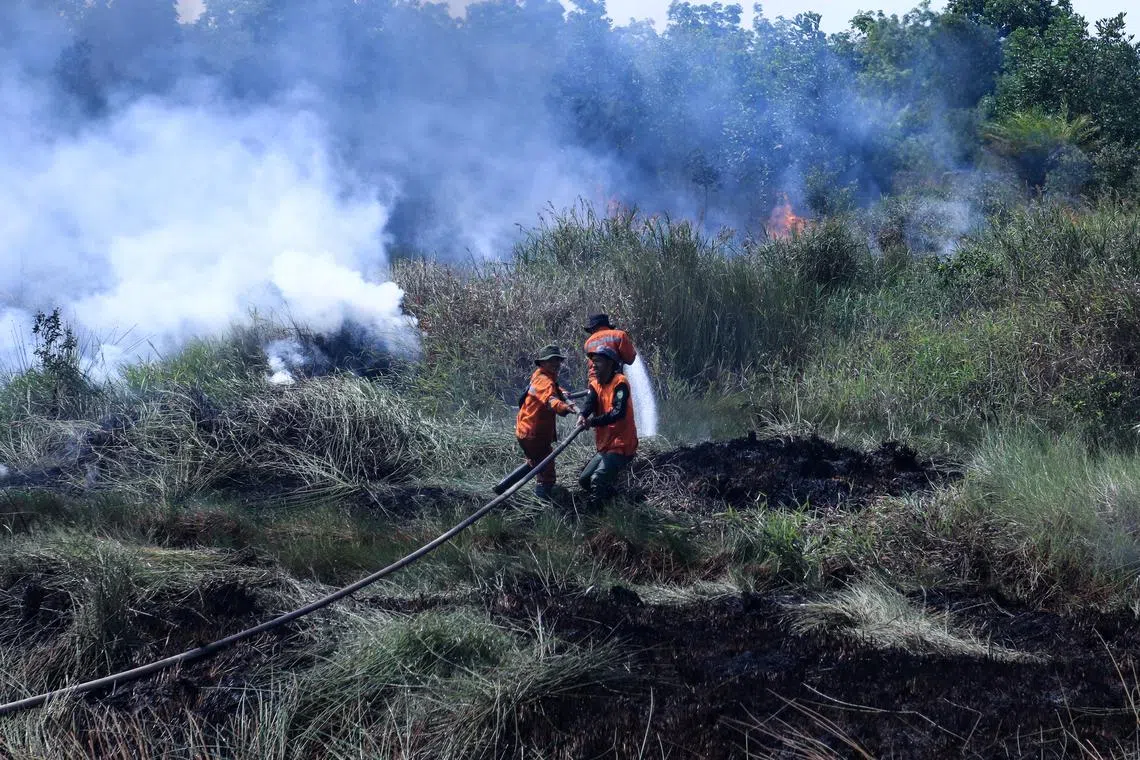More hot spots in Indonesia this week, but severe haze in Singapore not expected for now
Sign up now: Get ST's newsletters delivered to your inbox

Indonesian firefighters battling forest and land fires in a village,in South Sumatra on Sept 1.
PHOTO: REUTERS
Follow topic:
SINGAPORE – The increased number of hot spots in Kalimantan and Sumatra
According to the Weather and Climate Services for Asean, the number of hot spots had spiked to 93 in Kalimantan and 62 in Sumatra on Monday, the highest in the last seven days.
Associate Professor Steve Yim, principal investigator at the Earth Observatory of Singapore (EOS) at Nanyang Technological University, said the level of PM2.5 – fine particulate matter that can penetrate deeply into the lungs – has increased consistently, which is an obvious signal of regional air pollution. PM2.5 is the dominant pollutant during haze episodes.
At 5pm on Tuesday, Singapore’s 24-hour Pollutant Standards Index, or PSI, was within the moderate range at 73.
While rain has kept the haze in check, Professor Rajasekhar Bala, from the Department of Civil and Environmental Engineering at the National University of Singapore, said the location and intensity of peat and vegetation fires should also be closely monitored.
Freelance atmospheric scientist Erik Velasco does not expect a smoke haze episode of the magnitude experienced in 1997, 2013 or 2015.
“Water levels in Indonesian peatlands shouldn’t be too low, due to the region’s rainy conditions caused by the presence of La Nina in previous years,” he said.
While La Nina usually brings wetter and cooler conditions, El Nino typically brings drier, hotter conditions to South-east Asia,
Dr Velasco added that Indonesia is far better equipped to prevent and put out fires nowadays. “It’s also possible that the Indonesian government’s efforts are helping to restore peatlands by keeping them wet,” he said.
Prof Bala said the current weather pattern suggests it is unlikely there will be the kind of prolonged dry spells experienced from 1997 to 1998 and in 2019, as right now “there are still some sporadic rain events occurring locally in Singapore”.
But transboundary haze is increasingly difficult to predict,
Dr Velasco said that with climate change, the dry conditions expected due to the El Nino event and the development of the Indian Ocean Dipole (IOD) are not yet evident.
The IOD is the difference in sea surface temperature between the western Indian Ocean and the eastern Indian Ocean south of Indonesia.
A positive IOD usually brings about drier weather.
But weather conditions for transboundary haze are emerging, warned Prof Yim, as according to climate observation and projections by EOS, El Nino has developed and is projected to be stronger in October and November, while the positive IOD is also very likely to have emerged.

